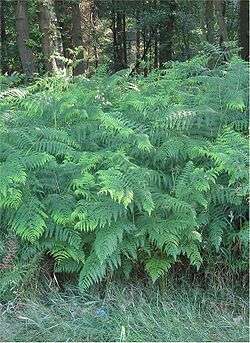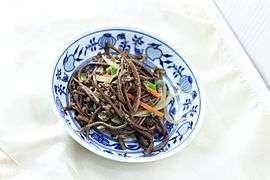Pteridium aquilinum
Pteridium aquilinum (bracken, brake or common bracken), also known as eagle fern, is a species of fern occurring in temperate and subtropical regions in both hemispheres. The extreme lightness of its spores has led to its global distribution.
| Pteridium aquilinum | |
|---|---|
 | |
| Scientific classification | |
| Kingdom: | Plantae |
| Clade: | Tracheophytes |
| Class: | Polypodiopsida |
| Order: | Polypodiales |
| Family: | Dennstaedtiaceae |
| Genus: | Pteridium |
| Species: | P. aquilinum |
| Binomial name | |
| Pteridium aquilinum | |
Etymology
Common bracken was first described as Pteris aquilina by Carl Linnaeus, in Volume 2 of his Species Plantarum in 1753. The origin of the specific epithet derived from the Latin aquila "eagle". In the reprint of the Flora Suecica in 1755, Linnaeus explains that the name refers to the image of an eagle seen in the transverse section of the root.[1] In spite of this, the opinion has been forwarded that the name pertains to the shape of the mature fronds appearing akin to an eagle's wing.[2] However, medieval scholars, including Erasmus, thought the pattern of the fibres seen in a transverse section of the stipe resembled a double-headed eagle or oak tree.
Taxonomy
It was traditionally treated as the sole species in the genus Pteridium (brackens); authorities have split and recognised up to 11 species in the genus, however. It was placed in the genus Pteridium by Friedrich Adalbert Maximilian Kuhn in 1879.[3]
Description
Common bracken is a herbaceous perennial plant, deciduous in winter. The large, roughly triangular fronds are produced singly, arising upwards from an underground rhizome, and grow to 0.3–1 m (1–3ft) tall; the main stem, or stipe, is up to 1 cm (0.4 in) diameter at the base. It dies back to ground level in autumn.[4]
- Amphicribral vascular bundle of a common bracken rhizome

Reproduction
Sporangia are formed in sori on the underside of the frond.[5] They are arranged in narrow brown bands, and form spores over July, August and September.[6]
Habitat
Bracken grows in pastures, deciduous and coniferous woodlands, and hillsides. It prefers acidic soils.[6]
An adaptable plant, bracken readily colonises disturbed areas. It can even be aggressive in countries where it is native, such as England, where it has invaded heather (Calluna vulgaris (L.) Hull) stands on the North Yorkshire moors.[7] In Ireland, bracken is found in open woodland and sandy pastures.[5]
Distribution
Bracken is native to Europe, Eastern Asia and North America. In America, it is found throughout the continental United States and the Canadian provinces of Ontario, Quebec, and Newfoundland. Its range's northern border extends to southern Alaska, while its southern reaches the northern portions of Mexico.[6]
Uses
Food
Bracken is a widely eaten vegetable in Korea, Japan and parts of China.[8] In Korea, bracken is known as gosari. It is soaked, parboiled, and stir-fried, and often eaten as a side dish (namul).[9] It is also a classic ingredient of bibimbap.[10] In Japan, young bracken shoots are steamed, boiled, or cooked in soups. The shoots are also preserved in salt, sake, or miso.[11] Bracken shoots have been used to produce beer in Siberia, and among indigenous peoples of North America.[11]
The rhizome can be ground into flour to make bread. In the Canary Islands, the rhizome was historically used to make a porridge called gofio.[11]
Bracken leaves are used in the Mediterranean region to filter sheep's milk, and to store freshly made ricotta cheese.[11]
 Dried bracken (gosari) from Korea
Dried bracken (gosari) from Korea Seasoned stir-fried braken (gosari namul) from Korea
Seasoned stir-fried braken (gosari namul) from Korea
Pharmacology
P. aquilinum has been investigated for its anti-inflammatory and antioxidative properties.[12]
Toxicity
The plant contains the carcinogenic compound ptaquiloside.[13] High stomach cancer rates are found in Japan and North Wales, where the young stems are used as a vegetable, but it is unknown whether bracken plays any part at all.[14] Consumption of ptaquiloside-contaminated milk is thought to contribute to human gastric cancer in the Andean states of Venezuela.[15] The spores have also been implicated as carcinogens.
However, ptaquiloside is water soluble, and is reduced by soaking bracken in cool water.[8] Korean and Japanese cooks have traditionally soaked the shoots in water and ash to detoxify the plant before eating.[11] Ptaquiloside also degenerates at room temperature, which explains why the rat studies were done with the toxin stored at −20 °C (−4 °F).[8] At boiling temperature, the carcinogen denatures almost completely.[8] Salt and baking soda also help with volatilizing the chemical.[8]
It has been suggested that selenium supplementation can prevent as well as reverse the immunotoxic effects induced by ptaquiloside from Pteridium aquilinum.[16]
References
- radix oblique dissecta refert aliquatenus aquilam imperialem
- Austin, Daniel F. (2004). Florida ethnobotany. CRC Press. p. 551. ISBN 978-0-8493-2332-4. Retrieved 30 June 2010.
- Thomson, John A. (2004). "Towards a taxonomic revision of Pteridium (Dennstaedtiaceae)". Telopea. 10 (4): 793–803.
- Clapham, A.R., Tutin, T.G. and Warburg, E.F. 1968 Excursion Flora of the British Isles. Cambridge University Press. ISBN 0-521-04656-4.
- Parnell, J. and Curtis, T. 2012. Webb's An Irish Flora. Cork University Press. ISBN 978-1-85918-478-3.
- Common Weeds of the United States. New York: Dover. p. 8. ISBN 0486205045.
- Whitehead, S J; Digby, J (1997). "The morphology of bracken (Pteridium aquilinum (L.) Kuhn) in the North York Moors—a comparison of the mature stand and the interface with heather (Calluna vulgaris (L.) Hull) 1. The fronds". Annals of Applied Biology. 131: 103–116. doi:10.1111/j.1744-7348.1997.tb05399.x.
- Shaw, Hank (30 June 2011). "The Bracken Fern: A Natural Born Killer?". The Atlantic. Retrieved 19 April 2017.
- Mishan, Ligaya (16 February 2017). "At Cafe Lily, the Korean-Uzbek Menu Evokes a Past Exodus". The New York Times. Retrieved 19 April 2017.
- Fontella, Amelia Cook (16 February 2017). "I brake for fernbrake". Isthmus. Retrieved 19 April 2017.
- Pieroni, Andrea (2005). Prance, Ghillean; Nesbitt, Mark (eds.). The Cultural History of Plants. Routledge. p. 35. ISBN 0415927463.
- Dion, C; Haug, C; Guan, H; Ripoll, C; Spiteller, P; Coussaert, A; Boulet, E; Schmidt, D; Wei, J; Zhou, Y; Lamottke, K (2015). "Evaluation of the anti-inflammatory and antioxidative potential of four fern species from China intended for use as food supplements". Natural Product Communications. 10 (4): 597–603. PMID 25973486.
- Gomes, Joana; Magalhães, Ana; Michel, Valérie; Amado, Inês F; Aranha, Paulo; Ovesen, Rikke G; Hansen, Hans C. B; Gärtner, Fátima; Reis, Celso A; Touati, Eliette (2012). "Pteridium aquilinum and Its Ptaquiloside Toxin Induce DNA Damage Response in Gastric Epithelial Cells, a Link with Gastric Carcinogenesis". Toxicological Sciences. 126 (1): 60–71. doi:10.1093/toxsci/kfr329. PMID 22143989.
- I A Evans; B Widdop; R S Jones; G D Barber; H Leach; D L Jones & R Mainwaring-Burton (1971). "The possible human hazard of the naturally occurring bracken carcinogen". Biochem. J. 124 (2): 29P–30P. doi:10.1042/bj1240029pa. PMC 1177200. PMID 5158492.
- Alonso‐Amelot, Miguel E; Avendaño, Marisabel (2001). "Possible association between gastric cancer and bracken fern in Venezuela: An epidemiologic study". International Journal of Cancer. 91 (2): 252–259. doi:10.1002/1097-0215(200002)9999:9999<::AID-IJC1028>3.0.CO;2-H.
- Latorre, A.O; Caniceiro, B.D; Wysocki, H.L; Haraguchi, M; Gardner, D.R; Górniak, S.L (2011). "Selenium reverses Pteridium aquilinum-induced immunotoxic effects". Food and Chemical Toxicology. 49 (2): 464–470. doi:10.1016/j.fct.2010.11.026. PMID 21112370.